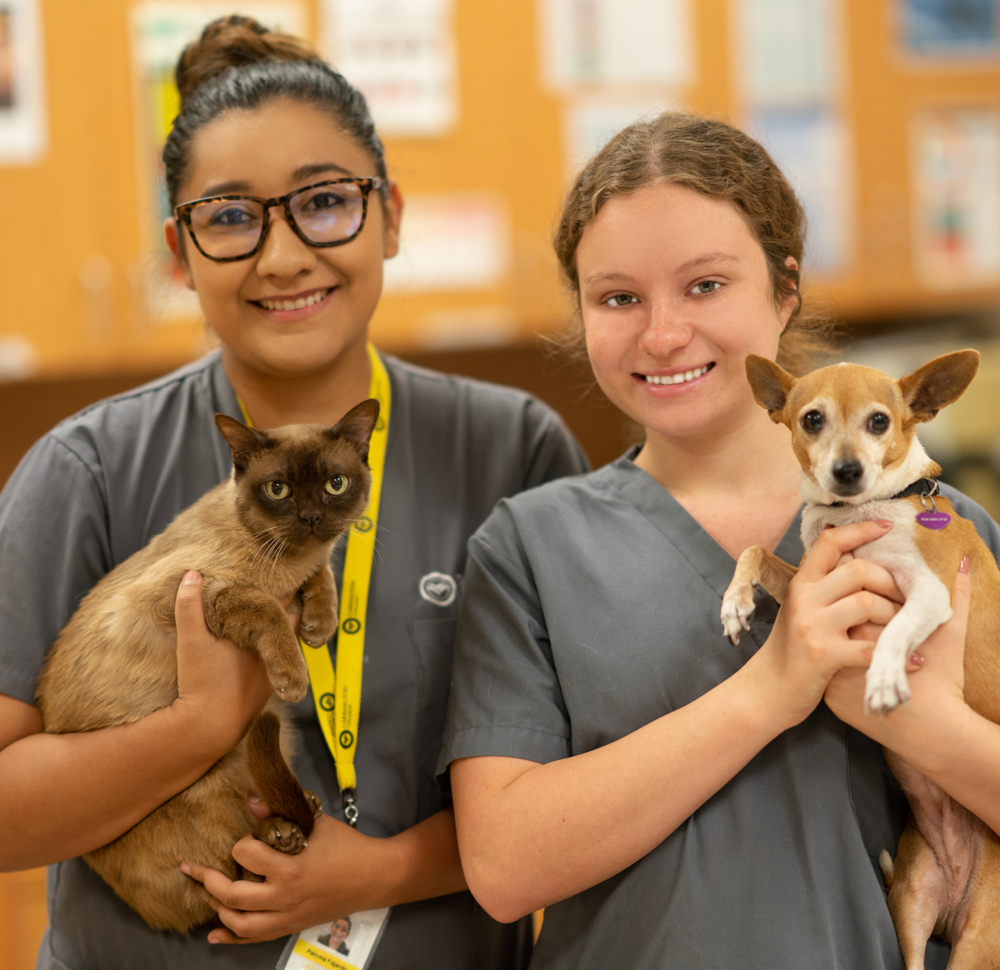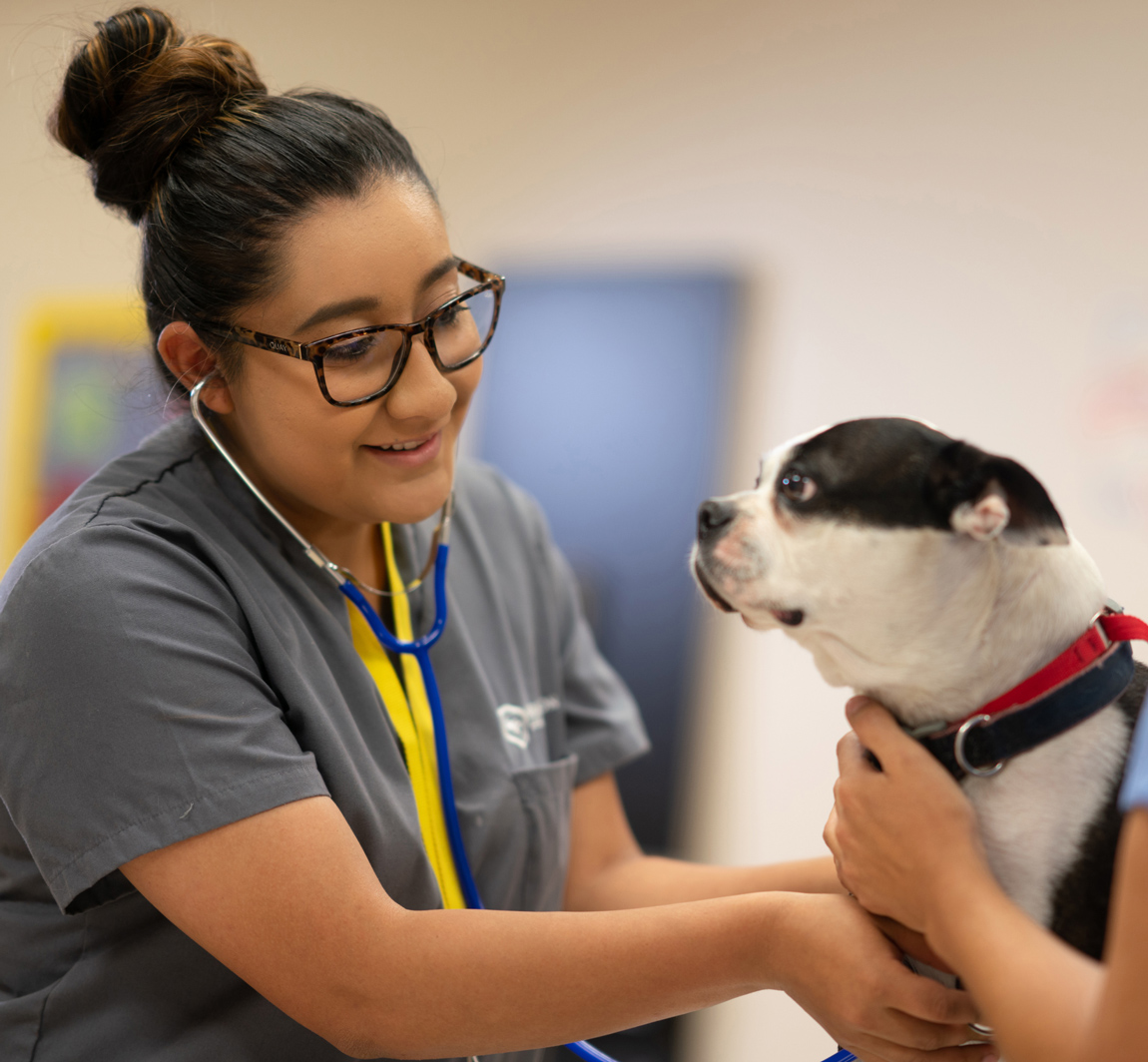Veterinary Technology
Carrington’s Veterinary Technology program prepares graduates to work under the supervision of a licensed veterinarian doing clinical work such as performing various medical tests and treating medical conditions and diseases in animals. Veterinary technologists and technicians do a variety of clinical, care, and laboratory tasks.1


Vet Tech Training Details
Cost & Financial Aid
Education is a major investment, but it’s an investment in your future. Every student comes to Carrington with unique financial needs. Carrington College is committed to helping you achieve your education goals. We participate in most financial assistance programs, both federal and state, as well as private financing. Each program has different requirements and application instructions. Student loans, grants, and scholarships are available to those who qualify.
For complete information on current tuition costs, please see page 236 of the Academic Catalog.
Location Availability
We’re proud to offer our accredited program in Veterinary Technology at five locations:
Program Specific Disclosures
MISSION
The mission of the Veterinary Technology program is to provide local and global veterinary communities with ethical graduates committed to lifelong learning and professional development. Graduates will have the entry-level skills and knowledge required for contemporary veterinary practice. The core program focus is companion animal practice, but all facets of veterinary medicine, including large animal medicine, biomedical research, and industry-related topics are emphasized.
Veterinary Technician National Exam (VTNE)
Three-year pass rate data for first-time test takers on the Veterinary Technician National Exam (VTNE) based on a July 1 to June 30 reporting year (July 1, 2020 – June 30, 2023)
| Number of first-time candidates that have taken the VTNE & Three-Year Pass Rate | ||
|---|---|---|
| Campus | Candidates | Pass Rate |
| Pleasant Hill | 74 | 63% |
| Sacramento | 108 | 50% |
| San Jose | 84 | 60% |
| San Leandro | 46 | 43% |
| Stockton | 73 | 39% |
Accreditation & Approvals
Carrington College is accredited by the Accrediting Commission for Community and Junior Colleges, Western Association of Schools and Colleges (ACCJC/WASC), 428 J Street, Suite 400, Sacramento, CA 95814; 415- 506-0234, an institutional accrediting body recognized by the Council for Higher Education Accreditation and the U.S. Department of Education.
Additional information about accreditation, including the filing of complaints against member institutions, can be found at accjc.org.
The Veterinary Technology programs at the Pleasant Hill, Sacramento, San Jose, San Leandro and Stockton campuses are accredited by the American Veterinary Medical Association as a program for educating veterinary technicians, www.avma.org/education/center-for-veterinary-accreditation/accreditation-veterinary-technicians.
For comprehensive information on Carrington’s accreditation and approvals, visit carrington.edu/accreditation-and-approvals/.

Request Information
Career Opportunities
A veterinary technician works under the supervision of a licensed veterinarian. Veterinary technologists and technicians typically work in private clinics and animal hospitals. They also may work in laboratories, colleges and universities, and humane societies.2
Vet tech responsibilities may include performing tests, analyzing samples, and preparing vaccines in a lab environment to diagnose and treat diseases in animals. Other times they work in a private clinical practice where they take on some responsibility of talking to and educating pet owners. They may assist veterinarians with surgical procedures or projects like biomedical research. They are responsible for the humane treatment of animals in research-related jobs.1

What Will I Learn?
Surgical Assisting
Anesthesia for Veterinary Technicians
Basic Anatomy and Physiology
Large Animal Medicine
Check out our guide on becoming a Veterinary Technician.
If you love animals and want to work with them professionally, a career as a veterinary technician offers you the chance to help animals in both in-person and research settings. You also have the chance to work with pet owners and ease their fears or educate them about their pets.

Veterinary Technology FAQ
How do you become a Veterinary Technician?
To be a Veterinary Technician, some states may need an Associate’s Degree or Bachelor’s Degree. And although the rules can vary by location, most states require a credentialing exam–or Veterinary Technician National Examination (VTNE), offered by the American Association of Veterinary State Boards.3
Here are a few steps to consider:
- Step 1: Get a high school diploma or GED equivalent. Those interested in becoming a veterinary technician can prepare by taking biology and other science courses in high school. If these classes aren’t offered at your school, you can still volunteer at a local animal clinic or shelter.
- Step 2: Complete an accredited degree program. Please note, that the American Veterinary Medical Association (AVMA) accredits both bachelor’s and associate degree programs.
- Step 3: Pass the credentialing exam. Most states require technicians to pass the Veterinary Technician National Examination (VTNE) administered by the American Association of Veterinary State Boards.
What can I do with a Veterinary Technology Associate Degree?
Earning an Associate Degree from Carrington College can prepare you for several opportunities in an animal facility. A sample of reported job titles include4:
- Veterinary Technician
- Emergency Veterinary Technician
- Veterinary Laboratory Technician
- Internal Medicine Veterinary Technician
How much does a Veterinary Technology Associate Degree cost?
The cost of a Veterinary Technology program depends on the school, its location, plus any financial aid you may receive. For program pricing information, refer to the current Carrington College Catalog.
How long is a Veterinary Technology program?
A Veterinary Technology program may take up to two years to complete, based on the certificate, diploma, or degree standards of your school. At Carrington College, you can earn an Associate Degree and prepare for the Veterinary Technician National Examination* in as few as 19 months.
Where can I work as a vet tech?
Veterinary technologists and technicians typically work in private clinics and animal hospitals. They also may work in laboratories, colleges and universities, and humane societies.2
How do you become a Veterinary Technician?
To be a Veterinary Technician, some states may need an Associate’s Degree or Bachelor’s Degree. And although the rules can vary by location, most states require a credentialing exam–or Veterinary Technician National Examination (VTNE), offered by the American Association of Veterinary State Boards.3
Here are a few steps to consider:
- Step 1: Get a high school diploma or GED equivalent. Those interested in becoming a veterinary technician can prepare by taking biology and other science courses in high school. If these classes aren’t offered at your school, you can still volunteer at a local animal clinic or shelter.
- Step 2: Complete an accredited degree program. Please note, that the American Veterinary Medical Association (AVMA) accredits both bachelor’s and associate degree programs.
- Step 3: Pass the credentialing exam. Most states require technicians to pass the Veterinary Technician National Examination (VTNE) administered by the American Association of Veterinary State Boards.
What can I do with a Veterinary Technology Associate Degree?
Earning an Associate Degree from Carrington College can prepare you for several opportunities in an animal facility. A sample of reported job titles include4:
- Veterinary Technician
- Emergency Veterinary Technician
- Veterinary Laboratory Technician
- Internal Medicine Veterinary Technician
How much does a Veterinary Technology Associate Degree cost?
The cost of a Veterinary Technology program depends on the school, its location, plus any financial aid you may receive. For program pricing information, refer to the current Carrington College Catalog.
How long is a Veterinary Technology program?
A Veterinary Technology program may take up to two years to complete, based on the certificate, diploma, or degree standards of your school. At Carrington College, you can earn an Associate Degree and prepare for the Veterinary Technician National Examination* in as few as 19 months.
Where can I work as a vet tech?
Veterinary technologists and technicians typically work in private clinics and animal hospitals. They also may work in laboratories, colleges and universities, and humane societies.2